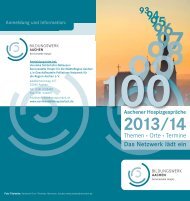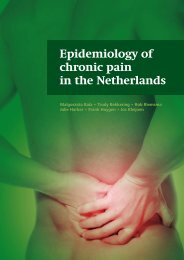First EFIC® Symposium Societal Impact of Pain - SIP
First EFIC® Symposium Societal Impact of Pain - SIP
First EFIC® Symposium Societal Impact of Pain - SIP
Create successful ePaper yourself
Turn your PDF publications into a flip-book with our unique Google optimized e-Paper software.
98<br />
Eva Zebedin-Brandl<br />
Dr. Eva Zebedin-Brandl PhD<br />
Department <strong>of</strong> Pharmaceutical Affairs<br />
Main Association <strong>of</strong> Austrian Social Security<br />
Institutions<br />
Pharmaco-economical aspects on the cost<br />
<strong>of</strong> pain<br />
Eva Zebedin-Brandl and Thomas Burkhardt<br />
Pharmaceutical expenditure continued to rise<br />
steadily in Austria during the 1990s and early<br />
2000s despite a variety <strong>of</strong> reforms. As reviewed<br />
in Godman et al (2008), recent reforms<br />
and initiatives have moderated the growth rate.<br />
Overall, health care in Austria seems well established,<br />
and a total <strong>of</strong> 98% <strong>of</strong> Austrians are<br />
covered by social (statutory) health insurance.<br />
However, providing modern and comprehensive<br />
medical care is inevitably and causally linked to<br />
a constant rise in health care costs. This rising<br />
financial burden is a common concern, coping<br />
strategies vary among different European<br />
states due to differences in health care structures<br />
and administrative impact. In Austria, the<br />
HVB (Main Association <strong>of</strong> Austrian Social Security<br />
Institutions) publishes the Reimbursement<br />
Code (EKO) for outpatient medicines, and<br />
if new medicines apply for inclusion they are<br />
subjected to pharmacological, medical/therapeutic<br />
and health economic evaluation.<br />
Treatment <strong>of</strong> pain has a unique position in each<br />
health care system. <strong>Pain</strong> patients are confronted<br />
both with severe and disabling physical<br />
as well as psychological burdens. Good medical<br />
care is the only way to avoid social marginalization.<br />
Very <strong>of</strong>ten pain perception includes psychosomatic<br />
and mental aspects. In this study<br />
we basically distinguish between two main<br />
treatment groups as representatives for pain<br />
medication: classical NOAs (non-opioid analgesics)<br />
and opioids. We aim to investigate the<br />
impact <strong>of</strong> social factors on prescribing habits<br />
and/or patients’ pain medication in these two<br />
groups. <strong>First</strong> we are interested if there are<br />
gross differences in the <strong>of</strong> the age distribution<br />
between the two groups in Austria. Next we<br />
are interested in the impact <strong>of</strong> recent social<br />
reforms. This can easily be followed over time<br />
and we hope to learn if and how greater availability<br />
or the restriction <strong>of</strong> pain medication (e.g.<br />
due to the introduction <strong>of</strong> generics) or the waiving<br />
<strong>of</strong> prescription fees influence the rate <strong>of</strong><br />
utilization <strong>of</strong> pain medication. Another interesting<br />
social aspect is the seasonal influence on<br />
pain medication. We intend to analyze the<br />
monthly fluctuations in utilization and try to<br />
identify seasonal factors, e.g. use <strong>of</strong> antipyretics<br />
for upper respiratory tract infections vs. opioids<br />
for more severe pain. Data were provided by<br />
the internal data warehouse <strong>of</strong> the HVB, which<br />
houses reimbursement data for ambulatory<br />
care from 2001-2009.






